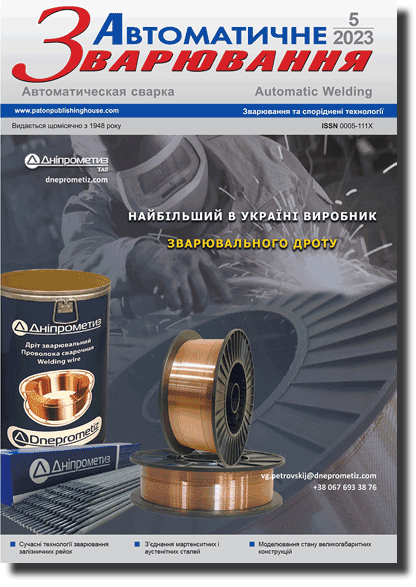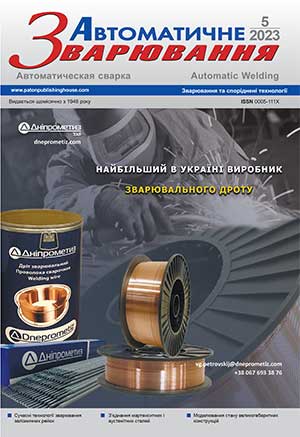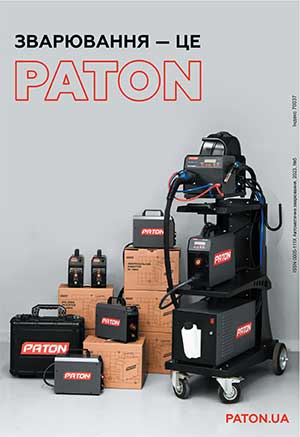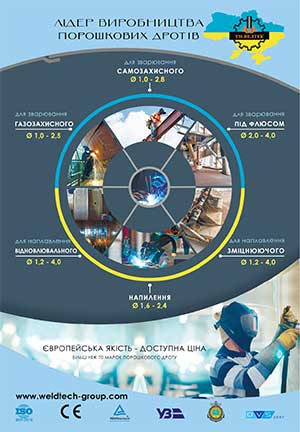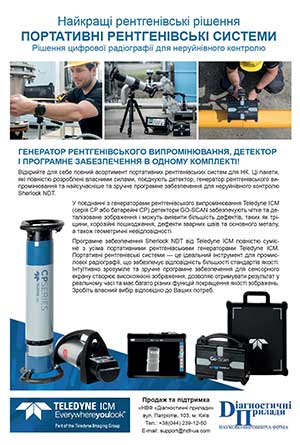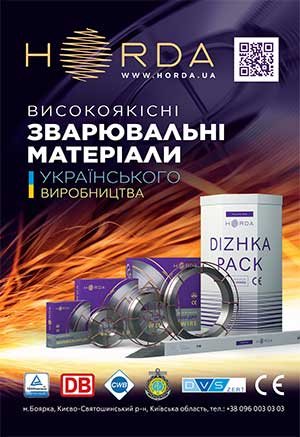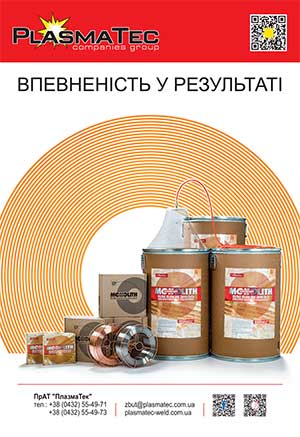| 2023 №05 (02) |
DOI of Article 10.37434/as2023.05.03 |
2023 №05 (04) |
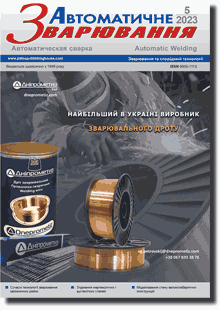
Журнал «Автоматичне зварювання», № 5, 2023, с. 27-36
Матеріали і технологічні підходи до зварювання комбінованих зʼєднань між мартенситними і аустенітними сталями, які використовуються в енергомашинобудуванні (Огляд)
М.О. Німко, В.Ю. Скульський, Т.В. Іваненко
ІЕЗ ім. Є.О. Патона НАН України. 03150, м. Київ, вул. Казимира Малевича, 11. E-mail: office@paton.kiev.uaНадано огляд недавньої зарубіжної дослідницької літератури, присвяченої вибору зварювальних матеріалів і актуальним підходам до зварювання комбінованих зʼєднань між мартенситними і аустенітними сталями, що широко застосовуються в даний момент у всьому світі і в тому числі й у вітчизняному енергомашинобудуванні. Розглянуто характерні представники мартенситних та аустенітних сталей; вказано проблеми, що виникають в зʼєднаннях різнорідних сталей при високотемпературній експлуатації, зокрема, процес дифузії вуглецю від менш легованої сталі до більш легованої та виникнення термічних напружень внаслідок різниці в коефіцієнтах термічного розширення поєднуваних сталей; описано технологічні підходи для зменшення негативного впливу вказаних вище факторів, а також наведено перспективні зварювальні матеріали, які використовуються при виготовленні таких зʼєднань, та проведено їх порівняльний аналіз. В кінці огляду приведено таблицю, в якій літературні посилання класифіковано в залежності від марки поєднуваних сталей та зварювальних матеріалів, що використовувалися при виготовленні зварних з’єднань у відповідних літературних джерелах. Бібліогр. 47, табл. 4, рис. 8.
Ключові слова: зварювальні матеріали, з’єднання різнорідних сталей, мартенситні сталі, аустенітні сталі, нікелеві сплави, дифузія вуглецю, зневуглецьований прошарок
Надійшла до редакції 12.04.2023
Список літератури
1. Shibli, A. (2014) Coal Power Plant Materials and Life Assessment. Woodhead Publishing.2. Huysmans, S., Vekeman, J., Hautfenne, C. (2017) Dissimilar metal welds between 9Cr creep strength enhanced ferritic steel and advanced stainless steels–creep rupture test results and microstructural investigations. Weld World, 61, 341–350.
3. Dak, G., Pandey, C. (2020) A critical review on dissimilar welds joint between martensitic and austenitic steel for power plant application. Journal of Manufacturing Processes, 58, 377–406.
4. Bhaduri, A. K., Venkadesan, S., Rodriguez, P., Mukunda, P. G. (1994) Transition metal joints for steam generators-An overview. International Journal of Pressure Vessels and Piping, 58(3) 251–265.
5. Wu, Q., Xua, Q., Jianga, Y., Gonga, J. (2020) Effect of carbon migration on mechanical properties of dissimilar weld joint. Engineering Failure Analysis, 117, 104935, 1–10.
6. Zhang, W.-Ch., Zhu, M.-L., Wang, K., Xuan, F.-Zh. (2018) Failure mechanisms and design of dissimilar welds of 9 %Cr and CrMoV steels up to very high cycle fatigue regime. International Journal of Fatigue, 113, 367–376.
7. Yong, J., Zuo, Zh., Jianming, G. (2015) Carbon diffusion and its effect on high temperature creep life of Cr5Mo/A302 dissimilar welded joint. Acta Metallurgica Sinica, 51 (4), 393–399.
8. Frei, J., Alexandrov, B. T., Rethmeier, M. (2019) Low heat input gas metal arc welding for dissimilar metal weld overlays part III: hydrogen-assisted cracking susceptibility. Welding in the World, 63, 591–598.
9. Ul-Hamid, A., Tawancy, H.M., Abbas, N.M. (2005) Failure of weld joints between carbon steel pipe and 304 stainless steel elbows. Engineering Failure Analysis, 12, 181–191.
10. Sireesha, M., Albert, S. K., Shankar, V., Sundaresan, S. (2000) A comparative evaluation of welding consumables for dissimilar welds between 316LN austenitic stainless steel and Alloy 800. Journal of Nuclear Materials, 279, 65–76.
11. Singh, S., Singh, A.B., Kumar, M. et al. (2021) Dissimilar Metal Welds used in AUSC Power Plant, Fabrication and Structural Integrity Issues. IOP Conf. Series: Materials Science and Engineering, 1017, 012022.
12. Karthick, K., Malarvizhi, S., Balasubramanian, V., Gourav Rao, A. (2018) Tensile properties variation across the dissimilar metal weld joint between modified 9Cr–1Mo ferritic steel and 316LN stainless steel at RT and 550 °C. Metallography, Microstructure and Analysis, 7, 209–221.
13. Lee, H.-Y., Lee, S.-H., Kim, J.-B., Lee, J.-H. (2007) Creep– fatigue damage for a structure with dissimilar metal welds of modified 9Cr–1Mo steel and 316L stainless steel. International Journal of Fatigue, 29, 1868–1879.
14. Mahajan, S., Chhibber, R. (2020) Investigations on dissimilar welding of P91/SS304L using Nickel-based electrodes. Materials and Manufacturing Processes, 35(9), 1010–1023.
15. Sireesha, M., Shankar, V., Albert, S. K., Sundaresan, S. (2000) Microstructural features of dissimilar welds between 316LN austenitic stainless steel and alloy 800. Materials Science and Engineering, A292, 74–82.
16. Sireesha, M., Albert, S. K., Sundaresan, S. (2002) Thermal cycling of transition joints between modified 9Cr–1Mo steel and Alloy 800 for steam generator application. International Journal of Pressure Vessels and Piping, 79, 819–827.
17. Sireesha, M., Albert, S. K., Sundaresan, S. (2003) Metallurgical changes and mechanical behavior during high temperature aging of welds between Alloy 800 and 316LN austenitic stainless steel. Materials Science and Technology, 19(10), 1411–1417.
18. Sireesha, M., Albert, S. K., Sundaresan, S. (2005) Influence of high-temperature exposure on the microstructure and mechanical properties of dissimilar metal welds between modified 9Cr-1Mo steel and Alloy 800. Metallurgical and Materials Transactions A, 36a, 1495–1506.
19. Laha, K., Chandravathi, K.S., Parameswaran, P. et al. (2012) A comparison of creep rupture strength of ferritic/austenitic dissimilar weld joints of different grades of Cr–Mo ferritic steels. Metallurgical and Materials Transactions A, 43A, 1174–1186.
20. Brentrup, G.J., Snowden, B.S., DuPont, J.N., Grenestedt, J.L. (2012) Design considerations of graded transition joints for welding dissimilar alloys. Welding Journal, 91, 252–259.
21. Akram, J., Kalvala, P.R., Misra, M., Charit, I. (2017) Creep behavior of dissimilar metal weld joints between P91 and AISI 304. Material Science and Engineering A, 688, 396–406.
22. Akram, J., Kalvala, P.R., Chalavadi, P., Misra, M. (2018) Dissimilar metal weld joints of P91/Ni alloy: microstructural characterization of HAZ of P91 and stress analysis at the weld interfaces. Journal of Materials Engineering and Performance, 27(8), 4115–4128.
23. Siefert, J.A., Tanzosh, J.M., Shingledecker, J.P. (2010) Weldability of EPRI P87. In: Advances in materials technology for fossil power plants: Proceedings from the 6th International Conference, August 31–September 3, 2010, Santa Fe, New Mexico, USA, 995–1013.
24. Siefert, J.A., Tanzosh, J.M., Shingledecker, J.P. et .al. (2011) EPRI P87: A Promising New Filler Metal for Dissimilar Metal Welding. Welding Journal, 90(3), 30–34.
25. Anand, R., Sudha, C., Karthikeyan, T. et al. (2009) Effectiveness of Ni-based diffusion barriers in preventing hard zone formation in ferritic steel joints. Journal of Materials Science, 44, 257–265.
26. Urzynicok, M., Jachym, R., Kwiecinski, K. et al. (2013) Application of EPRI87 in dissimilar welding austenitic-martensitic welded joints of TEMPALOY AA-1 and T92 steel grades. In: Advances in materials technology for fossil power plants: Proceedings from the 7th International Conference, October 22–25, 2013 Waikoloa, Hawaii, USA, 992–1005.
27. Coleman, K., Gandy, D. (2007) Alternative filler materials for DMWs involving P91 materials. In: Advances in materials technology for fossil power plants: Proceedings from the 5th International Conference, October 3–5, 2007, Marco Island, Florida, USA, 940–967.
28. Sirohi, S., Pandey, C., Goyal, A. (2021) Role of the Ni-based filler (IN625) and heat-treatment on the mechanical performance of the GTA welded dissimilar joint of P91 and SS304H steel. Journal of Manufacturing Processes, 65, 174–189.
29. Thakare, J.G., Pandey, C., Mahapatra, M.M., Mulik, R.S. (2019) An assessment for mechanical and microstructure behavior of dissimilar material welded joint between nuclear grade martensitic P91 and austenitic SS304 L steel. Journal of Manufacturing Processes, 48, 249–259.
30. Mittal, R., Sidhu, B.S. (2015) Microstructures and mechanical properties of dissimilar T91/347H steel weldments. Journal of Materials Processing Technology, 220, 76–86.
31. Senthil, T.S., Siva Kumar, G. (2015) Dissimilar steel welding of super heater coils for power boiler applications. American Journal of Materials Research, 2(5), 44–49.
32. Arunkumar, N., Duraisamy, P., Veeramanikandan, S. (2012) Evaluation of mechanical properties of dissimilar metal tube welded joints using inert gas welding. International Journal of Engineering Research and Applications, 2(5), 1709–1717. 33. Liang, Z., Gui, Y., Zhao, Q. (2018) Investigation of microstructures and mechanical properties of T92 martensitic steel/Super304 austenitic steel weld joints made with three welding consumables. Archives of Metallurgy and Materials, 63(3), 1249–1256.
34. Cao, J., Gong, Y., Zhu, K. et al. (2011) Microstructure and mechanical properties of dissimilar materials joints between T92 martensitic and S304H austenitic steels. Materials and Design, 32, 2763–2770.
35. Chen, G., Zhang, Q., Liu, J. et al. (2013) Microstructures and mechanical properties of T92/Super304H dissimilar steel weld joints after high-temperature ageing. Materials and Design, 44, 469–475. 36. Sharma, P., Kumar Dwivedi, D. (2019) Comparative study of activated flux-GTAW and multipass-GTAW dissimilar P92 steel-304H ASS joints. Materials and Manufacturing Processes, 34(11), 1195–1204.
37. Xu, L., Wang, Y., Jing, H. et al. (2016) Deformation Mechanism and Microstructure Evolution of T92/S30432 Dissimilar Welded Joint During Creep. Journal of Materials Engineering and Performance, 25, 3960–3971.
38. Liang, Z., Zhao, Q., Deng, J., Wang, Y. (2017) Influence of aging treatment on the microstructure and mechanical properties of T92/Super 304H dissimilar metal welds. Materials at High Temperatures, 35(2), 1–8. 39. Čiripová, L., Falat, L., Ševc, P. et al. (2018) Ageing effects on room-temperature tensile properties and fracture behavior of quenched and tempered T92/TP316H dissimilar welded joints with Ni-based weld metal. Metals, 8, 791–806.
40. Falat, L., Výrostková, A., Svoboda, M., Milkovič, O. (2011) The influence of PWHT regime on microstructure and creep rupture behaviour of dissimilar T92/TP316H ferritic/austenitic welded joints with Ni-based filler metal. Kovove Materialy, 49 (6), 417–426.
41. Falat, L., Čiripová, L., Kepič, J. et al. (2014) Correlation between microstructure and creep performance of martensitic/ austenitic transition weldment in dependence of its post-weld heat treatment. Engineering Failure Analysis, 40, 141–152. 42. Falat, L., Kepič, J., Čiripová, L. et al. (2016) The effects of postweld heat treatment and isothermal aging on T92 steel heat-affected zone mechanical properties of T92/TP316H dissimilar weldments. Journal of Materials Research, 31(10), 1532–1543.
43. Cao, J., Gong, Y., Yang, Z.G. (2011) Microstructural analysis on creep properties of dissimilar materials joints between T92 martensitic and HR3C austenitic steels. Materials Science and Engineering A, 528, 6103–6111.
44. Fei, Z., Pan, Z., Cuiuri, D. et al. (2020) Effect of post-weld heat treatment on microstructure and mechanical properties of deep penetration autogenous TIG-welded dissimilar joint between creep strength enhanced ferritic steel and austenitic stainless steel. The International Journal of Advanced Manufacturing Technology, 108, 3207–3229.
45. Vidyarthy, R.S., Kulkarni, A., Dwivedi, D.K. (2017) Study of microstructure and mechanical property relationships of A-TIG welded P91–316L dissimilar steel joint. Material Science and Engineering A, 695, 249–257.
46. Sharma, P., Kumar Dwivedi, D. (2019) A-TIG welding of dissimilar P92 steel and 304H austenitic stainless steel: Mechanisms, microstructure and mechanical properties. Journal of Manufacturing Processes, 44, 166–178.
47. Thakare, J.G., Pandey, C., Gupta, A. et al. (2021) Role of the heterogeneity in microstructure on the mechanical performance of the Autogenous Gas Tungsten Arc (GTA) welded dissimilar joint of F/M P91 and SS304L steel. Fusion Engineering and Design, 168, 112616, 1–13.
Реклама в цьому номері:
Вартість передплати/замовлення на журнали або окремі статті
| журнал/валюта | річний комплект друкований |
1 прим. друкований |
1 прим. електронний |
одна стаття (pdf) |
| AS/UAH | 1800 грн. | 300 грн. | 300 грн. | 150 грн. |
| AS/USD | 192 $ | 32 $ | 26 $ | 13 $ |
| AS/EUR | 180 € | 30 € | 25 € | 12 € |
| TPWJ/UAH | 7200 грн. | 600 грн. | 600 грн. | 280 грн. |
| TPWJ/USD | 384 $ | 32 $ | 26 $ | 13 $ |
| TPWJ/EUR | 348 € | 29 € | 24 € | 12 € |
| SEM/UAH | 1200 грн. | 300 грн. | 300 грн. | 150 грн. |
| SEM/USD | 128 $ | 32 $ | 26 $ | 13 $ |
| SEM/EUR | 120 € | 30 € | 25 € | 12 € |
| TDNK/UAH | 1200 грн. | 300 грн. | 300 грн. | 150 грн. |
| TDNK/USD | 128 $ | 32 $ | 26 $ | 13 $ |
| TDNK/EUR | 120 € | 30 € | 25 € | 12 € |
AS = «Автоматичне зварювання» - 6 накладів на рік;
TPWJ = «PATON WELDING JOURNAL» - 12 накладів на рік;
SEM = «Сучасна електрометалургія» - 4 наклада на рік;
TDNK = «Технічна діагностика та неруйнівний контроль» - 4 наклада на рік.





